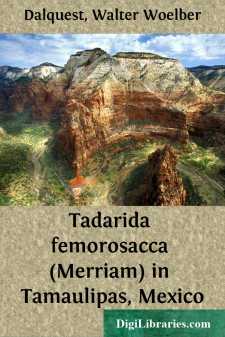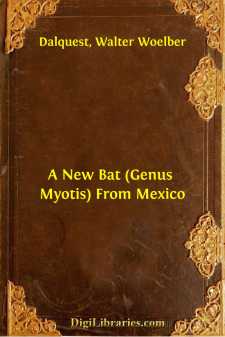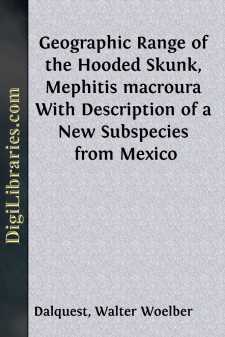Categories
- Antiques & Collectibles 13
- Architecture 36
- Art 48
- Bibles 22
- Biography & Autobiography 813
- Body, Mind & Spirit 142
- Business & Economics 28
- Children's Books 17
- Children's Fiction 14
- Computers 4
- Cooking 94
- Crafts & Hobbies 4
- Drama 346
- Education 46
- Family & Relationships 57
- Fiction 11829
- Games 19
- Gardening 17
- Health & Fitness 34
- History 1377
- House & Home 1
- Humor 147
- Juvenile Fiction 1873
- Juvenile Nonfiction 202
- Language Arts & Disciplines 88
- Law 16
- Literary Collections 686
- Literary Criticism 179
- Mathematics 13
- Medical 41
- Music 40
- Nature 179
- Non-Classifiable 1768
- Performing Arts 7
- Periodicals 1453
- Philosophy 64
- Photography 2
- Poetry 896
- Political Science 203
- Psychology 42
- Reference 154
- Religion 513
- Science 126
- Self-Help 84
- Social Science 81
- Sports & Recreation 34
- Study Aids 3
- Technology & Engineering 59
- Transportation 23
- Travel 463
- True Crime 29
A Synopsis of the American Bats of the Genus Pipistrellus
Description:
Excerpt
Four nominal species of the genus Pipistrellus are currently recognized in North America. They are
(F. Cuvier) of eastern North America, (H. Allen) of western North America, (Ward) from Veracruz, Mexico, and Miller from Tabasco, Mexico.In the past three years, specimens have been obtained in Veracruz (by Dalquest) of each of the southern species. One of these, P. cinnamomeus, previously was known from a single specimen; the other, P. veracrucis, was known only from six specimens which now are lost or misplaced. The results of our study of these recently acquired Mexican specimens constitute our principal contribution in this paper; we have done little more with the material from the United States and Canada than to codify the findings of other mammalogists with respect to the systematic status and geographic distribution.
Study of the available specimens reveals that there are only two species, and ; Pipistrellus veracrucis proves to be only a subspecies (geographic race) of P. subflavus, and Pipistrellus cinnamomeus proves to be a species of another genus, Myotis (see Hall and Dalquest, page 583 of this volume).
GenusPipistrellusKaup
1829. Pipistrellus Kaup, Skizzirte Entw.-Gesch. u. naturl. Syst. europ. Thierw., Vol. 1, p. 98, Type, Vespertilio pipistrellus Schreber (not seen by us, after Miller, N. Amer. Fauna, 13:87, 1897).
Range in the New World.âIn North America from southern Canada to Honduras (47 degrees to 5 degrees North Latitude) and from the Atlantic to the Pacific; not recorded from the West Indies or South America.
Characters.âSize small; tail approximately as long as outstretched leg; ears well developed with prominent tragus; dental formula: i.; c.; p.; m.; two upper incisors subequal and outer one lacking a concavity on surface facing canine; dentition otherwise essentially as in Myotis Kaup except that third premolar is always, instead of rarely, absent.
Remarks.âThere are two species in North America. Their geographic ranges, as now known, meet, but do not overlap. Certain differences between the two species are listed in the parallel columns below. Most of these differences in the skull and teeth are illustrated in figures 22 and 23 on page 92 of Miller's "Revision of the North American bats of the family Vespertilionidae (N. Amer. Fauna, 13, 1897)."
StructureColorPredominately grayPredominately brownFootLess than half as long as tibiaMore than half as long as tibiaThumb, length ofLess than 4.9 mm.More than 4.9 mm.TragusBlunt, terminal part bent forwardNarrow, straightSkull (dorsal profile)Nearly straightDish-facedBraincase (viewed from above)SmallLargePalateExtending far behind molars; spine short, narrow at baseExtending short distance long, wide at baseI2UnicuspidateBicuspidateI3Accessory cusp present on anterointernal faceAccessory cusp absent on anterointernal faceP1 (occlusal view)Less than a seventh as large as canineMore than a seventh as large as canineP1 (labial view)Concealed by C1 and P4Not concealedP4Touching canineNot touching caninei3Touching i2 and c1Separated by space from i2 and c1p3Lower than anterior cusp of canineAs high as anterior cusp of canineDistance from c1 to m1Less than length of m2; premolars crowdedMore than length of m2; premolars less crowded
Pipistrellus hesperus
(Synonomy under subspecies)
Range.âArid Sonoran life-zones of western North America from Washington southward to Jalisco....






